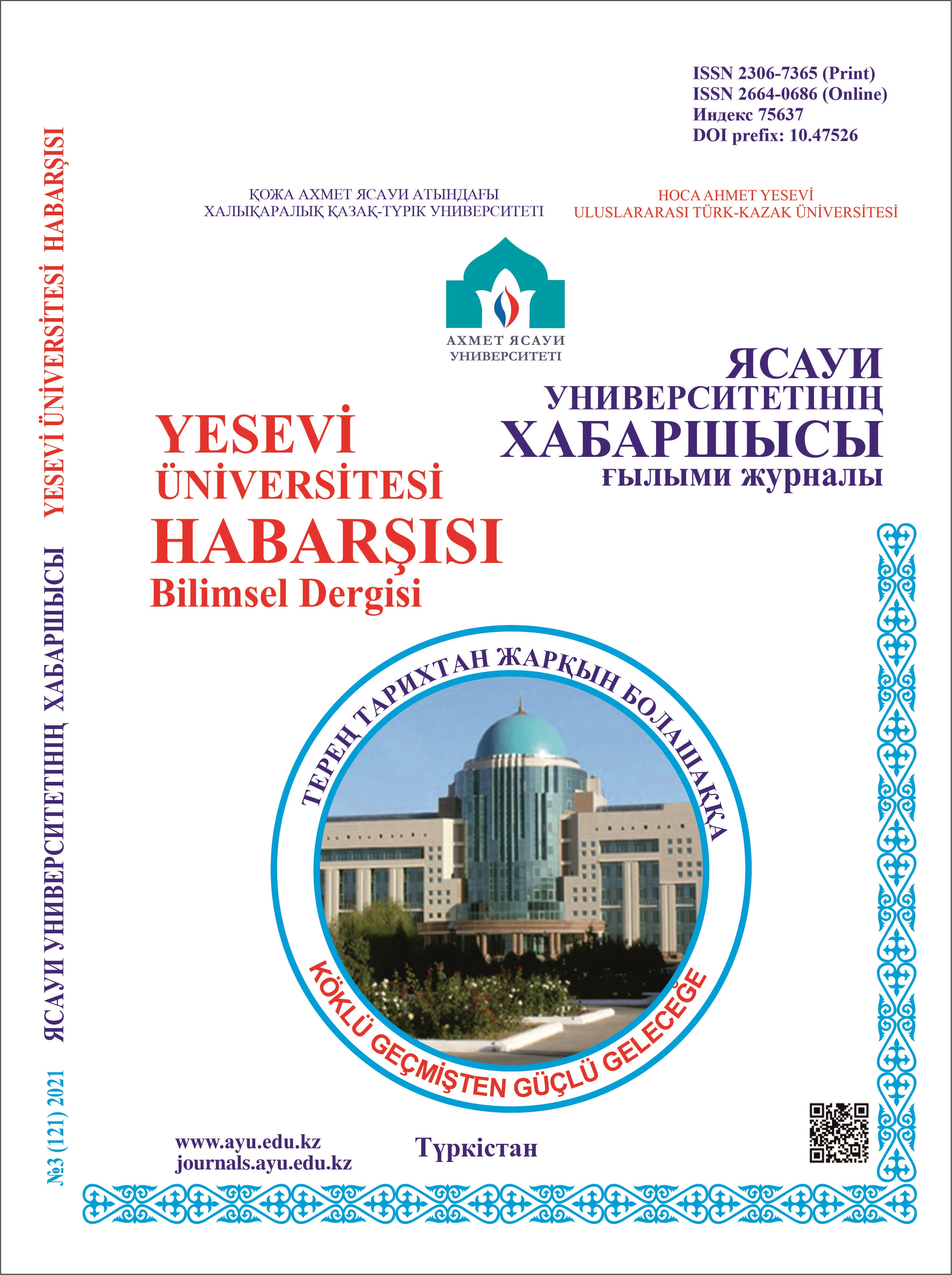Kazak Edebiyatında Doğu Gelenekleri ("Binbir Gece" Masalları Özelinde)
50 98
Anahtar Kelimeler:
classical oriental literature, motif, folklore, poetic transformation, dastan, genesis, typology.Özet
One of the relevant aspects of the study of modern comparative literature is the
study of the complex of motives and motional complexes. Modern literary critics attach great
importance to the motive and the motive complex. Because research on the motive and the motive complex in literature shows the influence of a certain literary period and individual folk literatures on the global literary process. Literary critics note that translated works are a separate aspect of the study, since the “plot-motive repertoire” of literature develops primarily due to translated works. The collection “One Thousand and One Nights” is recognized as one of the best examples of world literature. He entered the spiritual life, folklore and written literature of many peoples. “Tales of Scheherazade” is the most beautiful and highly artistic work among the remarkable monuments of oral literature. The life of the people is always reflected in its folklore. That is why the tale is a rich material for ethnocultural research. It will identify the main concepts of the national image of the world and track its changes. The tale is one of the traditions and genres that for many centuries have not lost their significance for world art culture. Subjects, motifs, images from folklore fairy tales are transmitted from generation to generation, play the role of carriers of cultural values and norms adopted in society. “A Thousand and One Nights” is a work that has become a phenomenon of mass culture in the fairy tale genre. There are many subjects and motives of this collection in world literature, Kazakh literature is no exception.
The article examines the origin, distribution around the world, the influence on world
literature of the book “One Thousand and One Nights”, which became a medieval Arabic
encyclopedia, including the poetic transformation of the motives of this collection in Kazakh
literature of the XIX–XX centuries. In addition, various variants of dastan SeifulmalikBadigulzhamal” from “One Thousand and One Nights” were investigated by a comparative analytical method.
Referanslar
Искусство повествования: Литературные исследования «Тысячи и одной ночи» / пер. с англ.
М.И. Герхард. – М.: Наука, 1984. – 455 с.
Хасен Ш. Тысяча и одна ночь: история и переводы // Филология и культура. – 2019. – №3 (53). –
Б. 56–63.
Бритвин В.Г. Собрание сказаний Востока: Тысяча и одна ночь. – М.: Вита Нова, 2022. – 512 с.
Салқынбаев М.Б. Қазақ және араб әдебиеті (Типология, генезис және аударма мәселелері). –
Астана: Астана полиграфия, 2009. – 208 б.
Липатова И.А., Назарова А.И. Сказки «Тысяча и одна ночь» как источник по истории
ментальности Востока // Вестник Чувашского Университета. – 2014. – №1. – С. 94–105.
Умарова Г., Шарабасов С. Қазақ әдебиетінің тарихы. – Астана: Фолиант, 2011. – 244 б.
Сүлейменов Р.Б., Моисеев В.В. Шоқан Уәлиханов – шығыстанушы. – Алматы: Ғылым, 1985. –
б.
Қазақ әдебиеті. Энциклопедиялық анықтамалық. – Алматы: «Аруна Ltd» ЖШС, 2021. – 356 б.
Әбжет Б.С. Қолжазба қорларында сақталған қазақ ертегілерін тізімге алу, жариялаудың ғылыми
маңыздылығы // Ясауи университетінің хабаршысы. – 2021. –№3(121). – Б. 7–15.
https://doi.org/10.47526/habarshy.v3i121.729
Саңлақ. Қалтай Мұхамеджанов туралы естеліктер. – Алматы: Атамұра, 2004. –280 б.
Iskusstvo povestvovania: Literaturnye issledovania «Tysiachi i odnoi nochi» [Narrative Art: Literary
Research “One Thousand and One Nights”] / per. s angl. M.I. Gerhard. – M.: Nauka, 1984. – 455 s. [in
Russian]
Hasen Sh. Tysiacha i odna noch: istoria i perevody [A thousand and one nights: history and
translation] // Filologia i kultura. – 2019. – №3 (53). – B. 56–63. [in Russian]
Britvin V.G. Sobranie skazani Vostoka: Tysiacha i odna noch [Collected Tales of the East: A Thousand
and One Nights]. – M.: Vita Nova, 2022. – 512 s. [in Russian]
Salkynbaev M.B. Qazaq jаne arab adebieti (Tipologia, genezis jаne audarma maseleleri) [Kazakh and
Arabic literature (Typology, genesis and translation problems)]. – Astana: Astana poligrafia, 2009. –
b. [in Kazakh]
Lipatova I.A., Nazarova A.I. Skazki «Tysiacha i odna noch» kak istochnik po istorii mentalnosti
Vostoka [Fairy tales “A Thousand and One Nights” as a source on the history of the mentality of the
East] // Vestnik Chuvashskogo Universiteta. – 2014. – №1. – S. 94–105. [in Russian]
Umarova G., Sharabasov S. Qazaq adebietinin tarihy [History of Kazakh literature]. – Astana: Foliant,
– 244 b. [in Kazakh]
Suleimenov R.B., Moiseev V.V. Shokan Ualihanov – shygystanushy [Shokan Ualikhanov is an
orientalist]. – Almaty: Gylym, 1985. – 112 b. [in Kazakh]
Kazak adebieti. Enciklopedialyq anyqtamalyq [Kazakh literature. Encyclopedic handbook]. – Almaty:
«Aruna Ltd» ZhShS, 2021. – 356 b. [in Kazakh]
Abjet B.S. Koljazba qorlarynda saqtalgan qazaq ertegilerin tizimge alu, jarialaudyn gylymi
manyzdylygy [The scientific importance of listing and publishing Kazakh fairy tales preserved in
manuscript collections] // Iasaui universitetinin habarshysy. – 2021. – №3(121). – B. 7–15. [in Kazakh]
https://doi.org/10.47526/habarshy.v3i121.729
Sanlaq. Qaltai Muhamedjanov turaly estelikter [Memories of Kaltai Mukhamedzhanov]. – Almaty:
Atamura, 2004. – 280 b. [in Kazakh]

